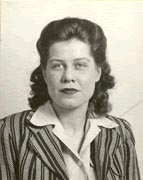Just hours after Britain declared war on Germany on September 3, 1939, the passenger liner Baird was working aboard as a stewardess was torpedoed by a German submarine, U-130. The liner, S.S. Athenia, was unarmed when the attack occurred. Between 112 and 118 people, many of them women and children, lost their lives in the sinking.
You won’t find merchant mariner Hannah Baird’s name in the history books, or the names of the other seven Canadian women who died while serving in merchant ships during both World Wars. Baird and the other women who perished in the Merchant Marine might be forgotten if not for the efforts of a few veterans and researchers.
“Because seamanship was considered ‘man’s work’, the contribution of women mariners during the wars has been overlooked and has not been included in histories of the period,” noted the late Tom Osborne. Osborne, a retired seaman, headed the Women Mariners Memorial Fund, an organization that aimed to make up for that oversight.
Together with Langford municipality on Vancouver Island, the group hit on a unique project to commemorate women mariners lost in action. In 2002, a large gazebo, the first and only free-standing memorial to women mariners in Canada, was dedicated to their memory at Langford’s Veterans Park. The gazebo is used for community activities such as concerts by the many youth bands in the area, fitting musical remembrance of these largely unsung women.
So just who were they, and how did they come to be in the line of fire?
Although women played only a small role in the Canadian merchant navy, there were some pioneers working as stewardesses, and a few Canadian women were radio officers on ships of the Norwegian merchant navy, the only Allied merchant fleet at that time that permitted women to serve aboard ships as wireless operators.
Very little is known of their backgrounds or their lives, and more research is needed to discover their personal and professional histories. Often, only their names, ships, and lengths of service at sea are available in the records. In part, this lack of information may be due to the fact that many of these women had their lives cut short before they could establish homes and families of their own, and so there are no direct descendants interested in tracing the past.
Eight Canadian women died, including Hannah Baird and Maude Elizabeth Steane, a 2nd Class radio operator who was just 28 when she was killed.
While working as a clerk at Toronto Hydro, Maude Steane enrolled at the Radio College of Canada to qualify as a Wireless Operator – 2nd Class.
In May of 1944, after completing her wireless operator training at the college of Canada, she joined the merchant ship S.S. Viggo Hansteen at New York. She was forced to seek work abroad because women who graduated with their radio operator tickets were banned from joining Canadian or any other Commonwealth ships.
They were also forbidden to join foreign ships in Canadian ports. So despite their new licences to operate ships’ radio, they were both unwanted and unappreciated in their homeland.
Seeking paid work and the opportunity to contribute to the war effort, they headed south to the United States to join the Norwegian ships which recognized their skills.
The Hansteen was an American-built Liberty Ship transferred to Norwegian registry for emergency war transport. Just ten weeks after leaving home, Maude Steane was killed. It is often reported that she died by enemy gunfire while her ship was docked in Naples, Italy. However, according to family sources, Steane was in fact shot and killed by one of S.S. Viggo Hansteen‘s male crew members, who then shot himself. Maude Steane is buried in the Allied War Cemetery near Florence, Italy.
Just ten weeks after leaving home, at the age of 28, Maude Elizabeth Steane was murdered aboard the HANSTEEN while anchored off Naples, Italy. She was shot by a male crew member who then turned the gun on himself. She was the first woman from Toronto killed on active service. She is buried in the Allied War Cemetary at Florence, Italy.
The other women honoured in the Langford memorial are:
Eliza Kennedy
stewardess aboard the S.S. Hesperian – killed September 4, 1915;
Jane Johnstone
stewardess aboard the S.S. Missanabie – killed September 9, 1918;
Mary Elizabeth Oliphant
stewardess aboard the S.S. Missanabie – killed September 9, 1918;
Lillie C. Cook-Gorbell
stewardess aboard the Lady Hawkins – killed January 19, 1942;
Eileen Pomeroy
second cook aboard the George L. Torian – killed February 22, 1942;
Bride Fitzpatrick
stewardess aboard the Caribou – killed October 14, 1944.
By Clare Sharpe
Museum staff member/webmaster


 CFB Esquimalt Naval and Military Museum
CFB Esquimalt Naval and Military Museum CFB Esquimalt Naval and Military Museum
CFB Esquimalt Naval and Military Museum